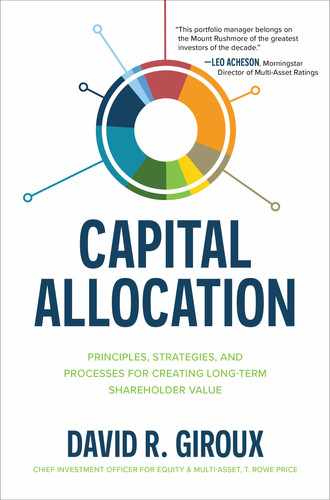Seize the competitive edge through intelligent, differentiated capital allocation The intelligent deployment of capital is one of the most effective ways to create long-term value. But despite this, there are very few capital allocation experts on the boards of the largest publicly traded companies, and academic research consistently finds that most firms deploy capital sub-optimally. Capital Allocation aims to educate senior leaders, board members, investors, students, and anyone interested in business on this important topic. Until now very little has been written on capital allocation outside of academia, even though the strategic deployment of excess capital is an increasingly significant source of competitive advantage for many companies. David Giroux, Chief Investment Officer for Equities and Multi-Asset and Head of Investment Strategy at T. Rowe Price, covers the entire gamut of capital allocation issues, including optimal capital structure, capital allocation alternatives, mergers & acquisitions, and special situations. Capital Allocation walks you through this critical topic from beginning to end, including: Capital Allocation offers everything you need to know for deploying capital wisely to outperform your competitors over the long term.
Giroux uses academic research, personal experience, and uncomplicated mathematics to reveal approaches and actions that create long-term value. He provides case studies from Kodak, Comcast, Thermo Fisher Scientific, Danaher, General Electric, Microsoft, and others showing how capital allocation has―and hasn’t―worked in real-life situations. And he shows how to use capital allocation to head off possible activist investors.
Table of Contents
- Cover
- Title Page
- Copyright Page
- Dedication
- Contents
- Acknowledgments
- Chapter 1. The Power of Capital Allocation
- Chapter 2. Capital Allocation in a Slow-Growth World
- Chapter 3. Optimizing the Capital Structure: Advantages of an Alternatives-Based Capital Allocation Framework
- Chapter 4. Five Stress Test Rules for Downturns
- Chapter 5. Capital Spending
- Chapter 6. Dividends and the Case for Returning Excess Capital to Shareholders
- Chapter 7. The “Regular-Special” Dividend: A New Way to Allocate Excess Capital
- Chapter 8. The (Alleged) Seven Deadly Sins of Share Repurchase
- Chapter 9. How Should Management Teams and Boards Think About Share Repurchase?
- Chapter 10. AutoZone: The Power of Intelligent Share Repurchase
- Chapter 11. Acquisitions
- Chapter 12. Complex Transactions
- Chapter 13. Superior Businesses with Lower Valuations
- Chapter 14. Private Deals
- Chapter 15. Distressed Sellers
- Chapter 16. Non-Core Divestitures
- Chapter 17. Short-Term Challenges, Long-Term Benefits
- Chapter 18. The Rise and Fall of the General Electric Empire
- Chapter 19. Inferior Businesses with Higher Valuations
- Chapter 20. Low-Return, Strategic Acquisitions: A Cautionary Tale
- Chapter 21. Supply/Demand Imbalance
- Chapter 22. Short-Term Plug Deal
- Chapter 23. Spin-Offs
- Chapter 24. Restructuring
- Chapter 25. Secular Challenges
- Chapter 26. Best Board Practices: The 14-Point Strategic Plan
- Chapter 27. Capital Allocation: Establishing a Long-Term Focus and Good Corporate Citizenship
- Chapter 28. Conclusions
- Appendix: The 14-Point Strategic Plan Checklist
- List of Abbreviations
- References
- Notes
- Index
